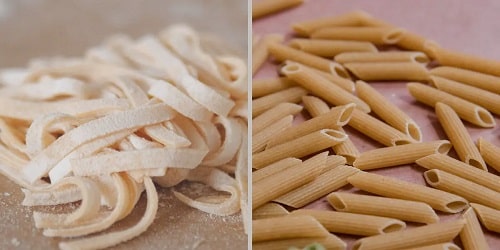Although they may look the same, fresh pasta and dried pasta have key differences that can influence the final result of your dishes. To help you decide which is the best option according to your recipe, we will tell you the main differences between the two.
Pasta is one of those simple and super versatile ingredients when it comes to cooking since it can be prepared in infinite ways depending on the type of pasta as well as the foods you use to prepare it. In fact, you can find a wide selection with the best pasta recipes for any occasion. But do you know what the difference is between fresh pasta and dry pasta? Although both types of well-cooked pasta are delicious, they have different characteristics that can affect the flavor and texture of the dish. So that you know when to choose each one, how to combine them with different ingredients, and how to get the most out of them, we show you their most striking differences.
What is dry pasta?
Dry pasta is a variety of pasta made from a mixture of ground ingredients, salt, and water that is subsequently dried to remove moisture. After kneading, which results in a homogeneous and elastic dough, it can be molded into various shapes to proceed to the drying process when all the moisture evaporates before proceeding to packaging.
What is fresh pasta?
Fresh pasta is normally a dough that mixes ground ingredients with eggs and does not dry out. After mixing the ingredients, they are kneaded until an elastic and consistent dough is obtained and given the desired shape. This type of pasta does not need to go through a drying process, but rather maintains moisture and is cooked directly.
Differences between dried pasta and fresh pasta
In addition to its ingredients and its preparation method – not to mention the most obvious, one is dry and the other is not – the differences between dry pasta and fresh pasta affect aspects such as cooking times, texture, and flavor. , its useful life and conservation or its culinary uses.
Ingredients: fresh pasta usually contains eggs
Dry pasta is made mainly from wheat semolina plus water and salt. In certain types of pasta, the dough also has egg among its main ingredients, as is the case with egg noodles. In any case, it is a paste that is left to dry so that it loses all its moisture.
As for the ingredients to prepare fresh pasta, only wheat flour and egg are needed —although sometimes water is used—and in this case they are not dried, but rather maintain moisture.
Cooking; fresh pasta is faster to cook
According to the manufacturer’s instructions, the cooking time of dry pasta may vary depending on its shape and size. But as a general rule, it takes 8 to 10 minutes of cooking to obtain an al dente pasta.
As for fresh pasta, unlike dry pasta that needs to be rehydrated, it will be cooked in a shorter period of time that may also vary depending on the type of pasta. In any case, fresh pasta will not need more than a couple of minutes to be al dente after cooking due to its high moisture content.
Texture and flavor: fresh pasta is more delicate
Once cooked, dry pasta is characterized by a neutral flavor and a firm, chewy yet resistant texture as long as it is cooked al dente. Thanks to its texture, it can withstand thicker sauces without its texture becoming softer over time.
Fresh pasta, on the other hand, has a richer and more delicate flavor thanks to the use of eggs among its main ingredients. The texture is softer, meatier, and more elastic than dry pasta.
Shelf life and conservation: dry pasta lasts longer
When it comes to dried pasta, if stored in a cool, dark place like the closet or pantry, it can last anywhere from months to even a few years in perfect condition. This is due to the complete removal of moisture during the drying process.
In reference to fresh pasta, it does not have a very long shelf life since it lacks preservatives. Being a fresh homemade pasta, you can store it for a couple of days in the refrigerator, or keep it in the freezer for up to 3 months.
Culinary uses: if you need firmness, dry pasta, or delicate things the fresh one
Dry pasta such as macaroni, elbows, paccheri, fusilli or rigatoni is ideal for dishes that require a firmer and smoother texture accompanied by strong sauces and a wide variety of ingredients, from macaroni to bolognese with meat chopped, even a pasta salad with chicken.
In dishes that require a softer and more delicate texture, the most suitable option is fresh pasta, which is ideal for making lasagna, ravioli, tortellini, and fettuccine, from the traditional meat lasagna or fettuccine Alfredo to soft stuffed ravioli. spinach and ricotta.
